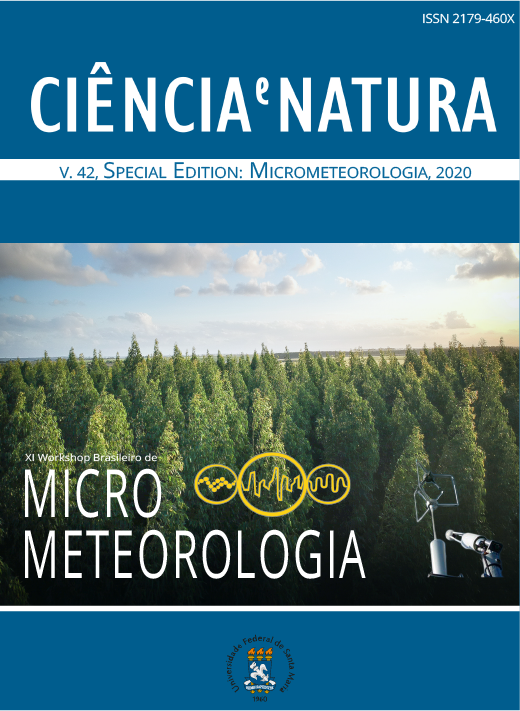Análise da influência do uso da parametrização cúmulus na simulação do vento com diferentes parametrizações de camada limite planetária
DOI:
https://doi.org/10.5902/2179460X53216Palavras-chave:
Vento, Parametrização, Camada limite planetáriaResumo
O presente trabalho teve como objetivo avaliar a Influência do uso da parametrização cúmulus na simulação do vento com duas dinstintas parametrizações de camada limite planetária, usando o modelo Weather Research and Forecast. Estudos sobre simulações de modelos usando parametrizações de CLP nas regiões tropicais são geralmente raros, principalmente devido a falta de observações experimentais. Este trabalho faz parte de projeto desenvolvido em parceria entre a UTE Pecém II, UTE Parnaíba I, Parnaíba II e III geração de Energia S.A. e a Universidade Federal de Santa Maria-UFSM. O complexo de Usina Termo- elétrica (UTE) Parnaíba está localizado na cidade de Santo Antônio dos Lopes no Maranhão e é operado pela empresa brasileira Eneva. Como a produção de energia através da combustão de gás natural produz resíduos que são lançados na atmosfera, os órgãos ambientais reguladores demandam que medidas de veri- ficação e controle sejam tomadas, como o monitoramento de espécies químicas. Logo, uma boa descrição da atmosfera é fundamental para o bom desemprenho dos modelos de dispersão de espécies químicas. Foram usados dados 4 estações meteorológicas automáticas para validação das simulações do modelo. o modelo teve dificuldade em reproduzir os valores magnitude do vento conforme os observados.
Downloads
Referências
GRELL, G. A.; FREITAS, S. R. et al. A scale and aerosol aware stochastic convective parameterization for weather and air quality modeling. Atmos. Chem. Phys, v. 14, n. 10, p. 5233–5250, 2014.
HONG, S.-Y.; DUDHIA, J.; CHEN, S.-H. A revised approach to ice microphysical processes for the bulk parameterization of clouds and precipitation. Monthly Weather Review, v. 132, n. 1, p. 103–120, 2004.
HONG, S.-Y.; PAN, H.-L. Nonlocal boundary layer vertical diffusion in a medium-range forecast model. Monthly weather review, v. 124, n. 10, p. 2322–2339, 1996.
MOLION, L. C. B.; BERNARDO, S. O. Uma revisão da dinâmica das chuvas no nordeste brasileiro. Revista Brasileira de Meteorologia, v. 17, n. 1, p. 1–10, 2002.
NAKANISHI, M.; NIINO, H. An improved mellor–yamada level-3 model with condensation physics: Its design and verification. Boundary-layer meteorology, Springer, v. 112, n. 1, p. 1–31, 2004.
PINTO, L. Avaliação do modelo WRF para aplicação em previsão de recursos eólicos no nordeste brasileiro. 2017. Tese (Doutorado) — Tese de Doutorado. Curso de Pós-Graduação em Ciência do Sistema Terrestre . . . , 2017.
SILVA, A. F.; FISCH, G. Avaliação do modelo wrf para a previsão do perfil do vento no centro de lançamento de alcântara. Revista Brasileira de Meteorologia, SciELO Brasil, v. 29, n. 2, p. 259- 270, 2014.
STULL, R. An introduction to boundary layer meteorology. Dordrecht: Kluwer Academic Publishers, 1988. 666 p.
WILKS, D. Statistical Methods in the Atmospheric Sciences. 2ª edição. San Diego: Academic Press, 2006. 648 p.
Downloads
Publicado
Como Citar
Edição
Seção
Licença
Para acessar a DECLARAÇÃO DE ORIGINALIDADE E EXCLUSIVIDADE E CESSÃO DE DIREITOS AUTORAIS clique aqui.
Diretrizes Éticas para Publicação de Revistas
A revista Ciência e Natura está empenhada em garantir a ética na publicação e na qualidade dos artigos.
A conformidade com padrões de comportamento ético é, portanto, esperada de todas as partes envolvidas: Autores, Editores e Revisores.
Em particular,
Autores: Os Autores devem apresentar uma discussão objetiva sobre a importância do trabalho de pesquisa, bem como detalhes e referências suficientes para permitir que outros reproduzam as experiências. Declarações fraudulentas ou intencionalmente incorretas constituem comportamento antiético e são inaceitáveis. Artigos de Revisão também devem ser objetivos, abrangentes e relatos precisos do estado da arte. Os Autores devem assegurar que seu trabalho é uma obra totalmente original, e se o trabalho e / ou palavras de outros têm sido utilizadas, isso tem sido devidamente reconhecido. O plágio em todas as suas formas constitui um comportamento publicitário não ético e é inaceitável. Submeter o mesmo manuscrito a mais de um jornal simultaneamente constitui um comportamento publicitário não ético e é inaceitável. Os Autores não devem submeter artigos que descrevam essencialmente a mesma pesquisa a mais de uma revista. O Autor correspondente deve garantir que haja um consenso total de todos os Co-autores na aprovação da versão final do artigo e sua submissão para publicação.
Editores: Os Editores devem avaliar manuscritos exclusivamente com base no seu mérito acadêmico. Um Editor não deve usar informações não publicadas na própria pesquisa do Editor sem o consentimento expresso por escrito do Autor. Os Editores devem tomar medidas de resposta razoável quando tiverem sido apresentadas queixas éticas relativas a um manuscrito submetido ou publicado.
Revisores: Todos os manuscritos recebidos para revisão devem ser tratados como documentos confidenciais. As informações ou ideias privilegiadas obtidas através da análise por pares devem ser mantidas confidenciais e não utilizadas para vantagens pessoais. As revisões devem ser conduzidas objetivamente e as observações devem ser formuladas claramente com argumentos de apoio, de modo que os Autores possam usá-los para melhorar o artigo. Qualquer Revisor selecionado que se sinta desqualificado para rever a pesquisa relatada em um manuscrito ou sabe que sua rápida revisão será impossível deve notificar o Editor e desculpar-se do processo de revisão. Os Revisores não devem considerar manuscritos nos quais tenham conflitos de interesse resultantes de relacionamentos ou conexões competitivas, colaborativas ou outras conexões com qualquer dos autores, empresas ou instituições conectadas aos documentos.






